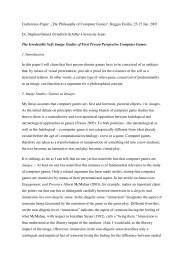Playing Dress-Up: Costumes, roleplay and imagination
Playing Dress-Up: Costumes, roleplay and imagination
Playing Dress-Up: Costumes, roleplay and imagination
You also want an ePaper? Increase the reach of your titles
YUMPU automatically turns print PDFs into web optimized ePapers that Google loves.
<strong>Playing</strong> <strong>Dress</strong>-<strong>Up</strong> Ludica<br />
At one extreme an almost indivisible principle, common to diversion, turbulence, free<br />
improvisation, <strong>and</strong> carefree gaiety...that can be designated by the term paidia. At the<br />
opposite extreme, this frolicsome <strong>and</strong> impulsive exuberance is almost entirely absorbed<br />
or disciplined by a complementary, <strong>and</strong> in some respects inverse, tendency to its anarchic<br />
<strong>and</strong> capricious nature: there is a growing tendency to bind it with arbitrary, imperative,<br />
<strong>and</strong> purposely tedious conventions...I call this second component ludus. (Caillois, 1958,<br />
p.13)<br />
The roots of this ludic bias in game studies are largely a product of its bias within the subject matter.<br />
Video games, on the whole, tend to be organized around game structures <strong>and</strong> mechanics that are more<br />
ludus than paidia. This may be due in part to the inherent nature of programming code, which dem<strong>and</strong>s<br />
logical structure <strong>and</strong> therefore lends itself to strict rule sets; it may also be due to the prevalence of male<br />
designers in the field who may tend to favor more ludic, goal-oriented forms of play. As a result of these<br />
factors, as well as the historical absence of dress-up play from formative analog games research, with a<br />
few notable exceptions, dress-up has been largely ignored in the scholarly study of digital play.<br />
From a feminist perspective, we can look at dress-up, which has historically been associated with female<br />
play, as fulcrum for the creation of more gender-inclusive games, as well as a bridge to more genderbalanced<br />
approaches to game studies. <strong>Dress</strong>-up <strong>and</strong> fashion have served as an entry-point for women <strong>and</strong><br />
girls into computer games, dating back to the “pink” game movement of the mid-1990s, as epitomized by<br />
the enormously successful Barbie Fashion Designer, <strong>and</strong> more recently by games such as The Sims,<br />
massively multiplayer online games (MMOGs) such as EverQuest <strong>and</strong> City of Heroes, <strong>and</strong> metaverses<br />
such as Second Life, in which dress-up <strong>and</strong> fashion play a significant role. Some of our research suggests<br />
that the computer may also serve as an entry-point for men into dress-up, for whom its convergence with<br />
technology may dispel some of its more feminine connotations. In this paper, we will explore the various<br />
social practices of dress-up play, both digital <strong>and</strong> non-digital, in attempt to open this as a topic for deeper<br />
exploration. This paper serves as a birds-eye view, <strong>and</strong> it is our hope that the questions posed here will be<br />
seen as a jumping off point for more detailed explorations of this topic by other designers <strong>and</strong> researchers.<br />
What is <strong>Dress</strong>-<strong>Up</strong>?<br />
What exactly do we mean by “playing dress-up?” How, precisely, do we play dress-up? What, in effect,<br />
are the mechanics of dress-up <strong>and</strong> how do they fit into traditional ideas about game design?<br />
In its purest form, the childhood engagement in costumed <strong>roleplay</strong>,‘dress-up” is clearly a form of openended,<br />
paidia-style play, <strong>and</strong> also falls into the category of what Caillois would call mimicry,’ defined as<br />
“…a diverse series of manifestations, the common element of which is that the subject makes believe or<br />
make others believe that he is someone other than himself. He forgets, disguises or temporarily sheds his<br />
personality in order to feign another.” (Caillois, 1958, p.19) Further, as Caillois specifies, “Many games<br />
do not imply rules. No fixed or rigid rules exist for playing with dolls, for playing soldiers, cops <strong>and</strong><br />
robbers, horses, locomotives <strong>and</strong> airplanes—games, in general, which presuppose free improvisation, <strong>and</strong><br />
the chief attraction of which lies in the pleasure of playing as a role, of acting as if one were someone or<br />
something else, a machine for example.” (p.8) According to Caillois, both ludis <strong>and</strong> paidia are compatible<br />
with mimicry (pp.30-31), thus dress-up can occupy different realms depending on the level of structure<br />
imposed on the activity.<br />
Caillois also points out that “…acts of mimicry tend to cross the border between childhood <strong>and</strong><br />
adulthood. The pleasure lies in being or passing for another.…the mask disguises the conventional self<br />
<strong>and</strong> liberates the personality” (p.21) <strong>and</strong> epitomizes “the pleasure in secrecy, make-believe or disguise.”<br />
(p.65) Therefore, we see a wide variety of costume <strong>and</strong> dress-up in adult spheres of play, <strong>and</strong> these may<br />
operate within varying degrees of structured social contracts. These rules may be considered “ludic” in<br />
Philosophy of Computer Games 2007 Page 3






